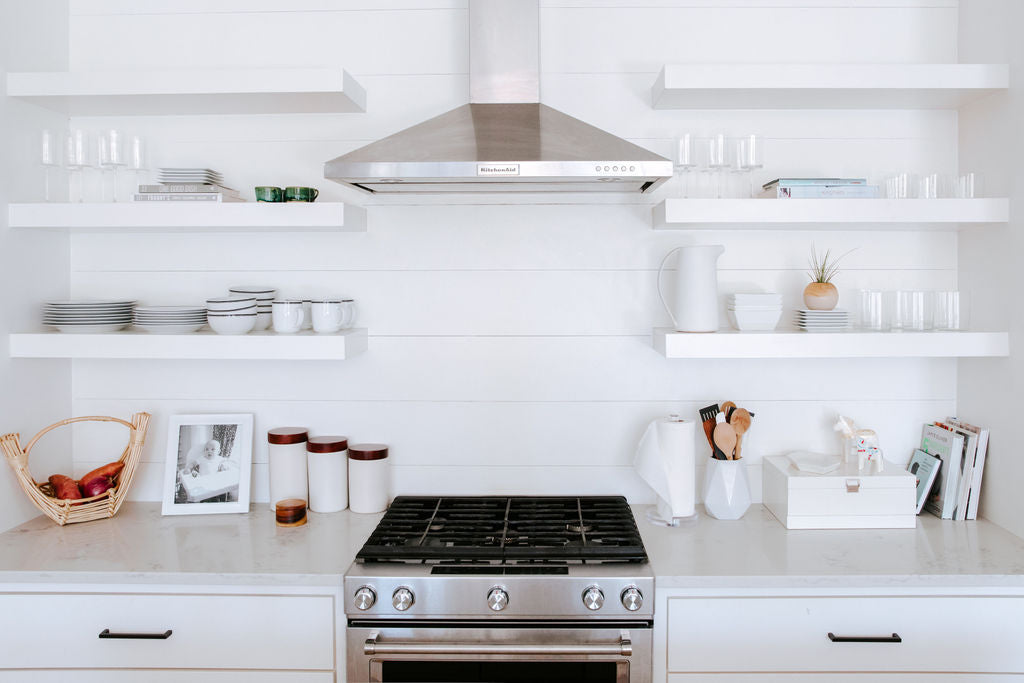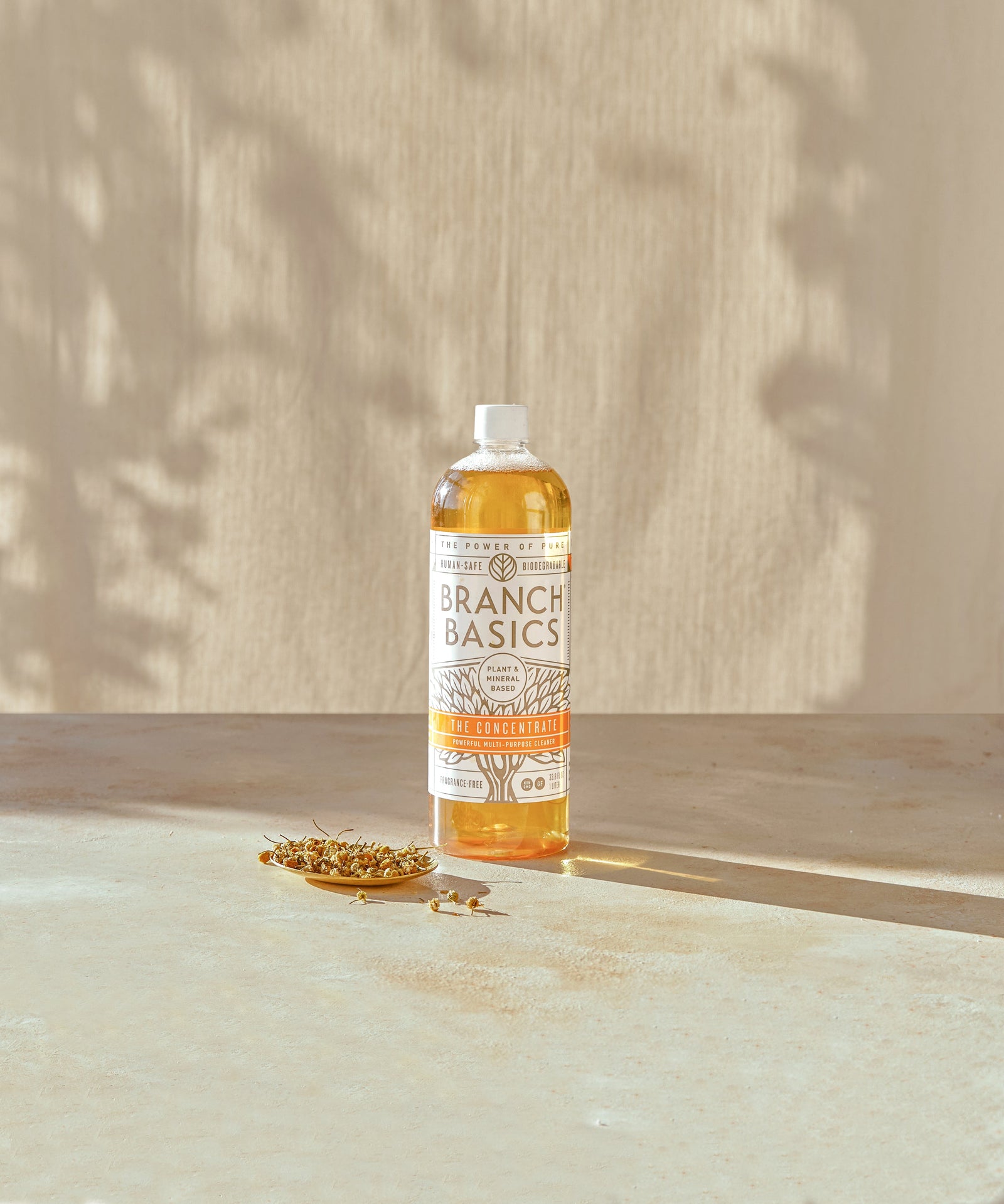How To Clean Stove Top Grates Naturally: 5+ Tips

Many people love the precision and fast-heating action of a gas range.
However, gas stove tops aren’t as easy to clean as glass top stoves.
They require regular cleaning to prevent build-up (which can become a fire hazard), and most are made of cast iron, which requires special care.
Although many experts recommend harsh cleaning chemicals, like ammonia or oven cleaner, for stove grates, they are entirely unnecessary and harmful to your health.
In this article, you’ll learn how to get your stove grates sparkling clean using only simple and natural products.
Materials And Tools Needed To Clean Stove Top Grates Naturally
Most stovetop grates are cast iron, which harsh chemicals or scrubbing tools, like steel wool, can easily damage.
Here’s what you’ll need to clean your stovetop grates naturally without damaging them:
- A non-scratch stiff bristle brush, like Branch Basics Natural Scrub Brush
- A non-scratch sponge will work too
- A large sink, bathtub, or large heat-proof basin for soaking
- The other option is to wash one or two grates at a time in a smaller space
- Branch Basics All-Purpose, Branch Basics Concentrate, Distilled white vinegar, or baking soda
- A towel
1: How To Clean Stove Top Grates With Branch Basics
Branch Basics is a human-safe all-in-one cleaning system designed to simplify cleaning by replacing every household cleaning and laundry product with just one Concentrate.
Branch Basics is a natural degreaser, and its powerful ingredients can easily break up cooked-on food and other kitchen messes.
For everyday cleaning of stovetop grates—and all kitchen surfaces, we love using All-Purpose—just spray on and wipe clean.
For weekly cleaning of stovetop grates or tougher jobs, we turn to the Concentrate as a soaking agent.
Here’s how to use Branch Basics Concentrate to deep clean your stovetop grates:
- Fill your sink, basin, or bathtub with enough boiling or very hot water to cover the stovetop grates.
- Add 1 teaspoon Concentrate for a large sinkful or 2 teaspoons to a shallow bathtub full.
- Soak for 30 minutes or several hours to release dirt, grease, grime, and baked-on food.
- Scour lightly with your natural brush or non-scratch scouring pad.
- Rinse and dry.
For very stubborn messes, add in Oxygen Boost
- For grates that haven’t been cleaned in weeks or super cooked-on messes, follow the above procedure, adding half to 1 scoop of Branch Basics Oxygen Boost.
- Soak for at least an hour, then scrub clean, rinse, and dry.
- If needed, add a little Oxygen Boost directly to your brush or scouring pad for extra no-scratch scouring power. However, soaking is typically sufficient.
Oxygen Boost combines the cleaning, degreasing, and scouring power of Sodium Bicarbonate (baking soda) with Sodium Percarbonate (aka oxygen bleach or powdered peroxide).
Learn more in: The Power Of Sodium Percarbonate For Cleaning.
2: How To Clean Stove Top Grates With Vinegar
Distilled white vinegar is an excellent alternative to highly toxic ammonia for degreasing and cleaning up stove grates fast.
Here’s how to use vinegar to clean stovetop grates:
- Use a paper towel or cleaning cloth to remove large food particles from the grates.
- Clean off the grates with hot soapy water. Vinegar is not a surfactant and doesn’t carry away grease and oil away like soaps or detergents.
- Fill your sink, basin, or bathtub with enough very hot water to cover the grates.
- Add half to 1 cup of distilled white vinegar.
- Let the grates soak for 15-30 minutes to overnight.
- Scrub using a natural brush or non-scratch scouring pad, if necessary.
- Rinse and wipe dry.
Please note: Although a natural product, vinegar contains acetic acid, which is a lung irritant when airborne.
If you use vinegar, make sure that there is good ventilation, that you do not inhale while it’s soaking, and that no one with a lung condition or respiratory weakness is present.
Related read: 12 Ways To Use Vinegar In Your Home.
3: How To Clean Stove Top Grates With Baking Soda
Baking soda is terrific for cleaning stove top grates as a soaking solution and non-abrasive scouring agent.
Here’s how to use baking soda two ways to clean stove top grates:
The soaking method (works best for tougher jobs, like once per-week cleaning):
- Fill your sink, basin, or bathtub with enough very hot water to cover the grates.
- Add half to 1 cup of baking soda.
- Let the grates soak for 15-30 minutes.
- Scrub using a natural brush or non-scratch scouring pad, if necessary. You can also add a little baking soda directly to the brush or pad for extra scouring power.
- Rinse and wipe dry.
The spray-and-scour method (works best for everyday cleaning):
- Spray your grates with Branch Basics All-Purpose or your favorite all-natural All-Purpose Cleaner.
- Sprinkle baking soda over the grates.
- Let dwell for 15-30 minutes.
- Scrub using a natural bristle brush or non-scratch scouring pad.
- Rinse, dry, and you’re done.
Related read: Cleaning With Baking Soda (Sodium Bicarbonate): 12 Surprising Uses.
4: How To Clean Stove Top Grates With A Pumice Stone
Still have some stubborn stains and residues on your stove grates? For the toughest greasy deposits try a simple pumice stone!
Keep wetting and rewetting the stone to keep it from scratching the grate surface.
Grate Cleaning FAQs
Now that you know the basics of how to clean stove top grates naturally let’s answer some FAQs.
How Can I Remove Burnt-On Food From Stove Grates Using Natural Products?
The best course of action is to clean the burnt food as soon as the grate cools.
However, when this isn’t possible, use one of the methods listed above, using Oxygen Boost or baking soda along with a pumice stone as an extra scouring agent.
How Often Should I Clean My Stove Grates?
Ideally we recommend wiping them down with Branch Basics All-Purpose, or your favorite natural all-purpose cleaner, after each use.
However, for most active families who cook regularly, weekly cleaning using one of these soaking methods is more realistic.
It’s important to clean stove grates when they’re completely cool to avoid burning yourself and to avoid the cleaner getting burnt onto the grate.
Can I Use Lemon Juice To Clean Stove Grates?
Yes. Lemon juice can be used in place of vinegar to clean your stove grates. Just follow the vinegar soaking procedure listed above.
Lemon juice can also be combined with baking soda and used for rust marks on stove grates. Here’s how:
- Combine lemon juice with baking soda to make a paste and apply to the rust.
- Place the grate in a plastic bag or cover with plastic wrap overnight.
- Remove from the bag or plastic wrap, and scrub away the rust with a non-scour pad or natural bristle brush.
Do You Recommend Oven Cleaner For Cleaning Stove Grates?
Oven cleaner has become a popular hack for cleaning stove grates. However, we do not recommend it for stove grates or ovens.
As discussed in Non-Toxic Oven Cleaning, How To Clean Ovens & Stovetops, chemicals in oven cleaners (even the fume-free varieties) such as caustic soda (aka potassium hydroxide), sodium hydroxide, lye, and esters are some of the most caustic and dangerous cleaning chemicals.
This is why most people are afraid of using oven cleaner and/or have families leave the house if they do use it. The stuff is extremely toxic and has no place in a healthy home, especially one with babies, children, pets, or anyone with chronic illness.
Instead, follow one of the procedures listed above, and click the link above for other non-toxic oven cleaning alternatives.
Toss the Toxins With Branch Basics
We are on a mission to help people live healthier lives by identifying and eliminating common toxins in their homes.
One of the best places to start is cooking more whole foods at home, giving you more control over the ingredients that go into your meals and snacks.
This inevitably means you’ll be cleaning your kitchen more often, which is where Branch Basics comes in.
If you’re new to Branch Basics, here’s how our super simple yet powerful cleaning system works: When you order a Branch Basics Premium Starter Kit (available in reusable plastic or glass), you’ll receive the Concentrate, Oxygen Boost, and five bottles to make your own All-Purpose, Bathroom, Streak-Free, Laundry, and Foaming Wash.
This provides you with everything you need to clean your entire home and do your laundry—plus washing your hands, cleaning produce, washing your car, washing your pets, cleaning jewelry, and so much more—naturally and without toxic chemicals.
To learn more about what’s in Branch Basics and how it works see:
- How To Get Started With Your Branch Basics Kit
- How Branch Basics Is A Natural & Sustainable Cleaning Line
And for more natural kitchen cleaning hacks, check out:

Marilee Nelson
Marilee Nelson is an Environmental Toxins expert who has spent nearly 30 years advocating for the chemically-sensitive and chronically-ill. She is a Board Certified Nutritionist, Certified Bau-Biologist and Bau-Biology Inspector and specializes in Food As Medicine. She has helped thousands of families and individuals identify, heal and recover from toxic exposures and is on a mission to revolutionize the way American families view their health.








